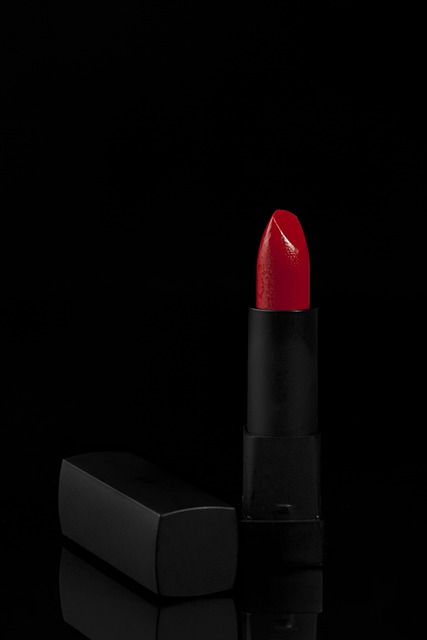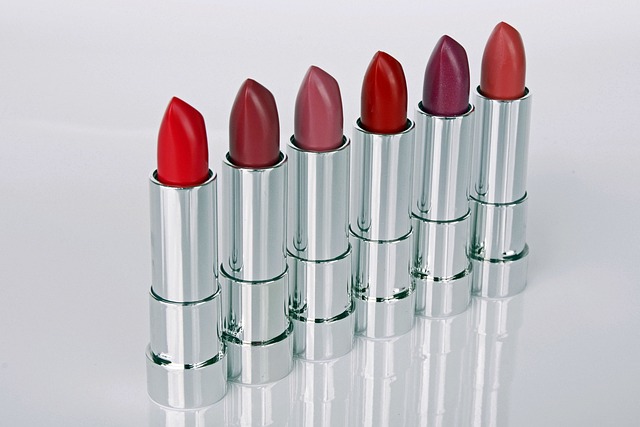Red lipstick has evolved from natural pigments to modern synthetic formulations over centuries. The 20th century brought a revolution in production with synthetic dyes, leading to diverse shades, improved textures, and enhanced safety standards. Today, it remains a global symbol of beauty, confidence, and personal expression. Crafted from various chemicals, including waxes, oils, and pigments, conventional lipsticks may contain harmful substances like lead and parabens, prompting consumers to opt for natural, organic alternatives with transparent ingredient lists. Global regulations and labeling guidelines ensure safety and quality in the cosmetic industry, empowering consumers to make informed choices about red lipstick while addressing health and environmental concerns.
Red lipstick, a timeless beauty staple, has evolved from ancient times to modern-day trends. Its history is a captivating tale of self-expression and cultural significance. This article delves into the world of cosmetics, exploring the common chemicals found in lipstick formulations and their potential health risks. We’ll navigate regulatory standards, dissect labeling practices, and offer tips on choosing safe, natural alternatives. Discover the science behind your favorite red lipstick and make informed decisions for healthier lips.
- The History and Evolution of Red Lipstick
- Common Chemicals Found in Lipstick Formulations
- Potential Health Risks Associated with Chemical Ingredients
- Regulatory Standards and Labeling for Cosmetic Products
- Choosing Safe and Natural Lipsticks: Tips and Recommendations
The History and Evolution of Red Lipstick

Red lipstick has a rich history that dates back centuries, evolving from simple natural pigments to sophisticated synthetic formulations. Historically, reds derived from natural sources like rubies, crayons made from wax and earth dyes, and even beetroot were used by ancient civilizations for adornment and symbolic purposes. Over time, the pursuit of more vibrant and lasting shades led to groundbreaking innovations.
In the 20th century, the development of synthetic dyes and pigments revolutionized red lipstick. These advancements enabled cosmetic companies to create a vast array of shades with improved texture, longevity, and safety standards. Today, red lipstick remains an iconic symbol of beauty, confidence, and personal expression, beloved by generations worldwide.
Common Chemicals Found in Lipstick Formulations

Lipstick, a staple in many beauty routines, contains a variety of chemicals that contribute to its texture, colour, and longevity. Common ingredients found in lipstick formulations include waxes like carnauba and beeswax, which provide structure and prevent creasing. Oils such as castor oil and coconut oil are added for moisture and comfort on the lips. These oils also help to bind the pigment, creating a smooth and vibrant finish, especially in red lipstick.
Pigments are another essential component, offering a wide range of colours from natural minerals like iron oxide for shades of red to synthetic dyes for more intense hues. Preservatives, such as parabens and phenoxyethanol, are used to extend the product’s shelf life by preventing bacterial growth. Additionally, flavouring agents and fragrances are often included to enhance the user experience, though some individuals may prefer lipsticks without these additives.
Potential Health Risks Associated with Chemical Ingredients

Many chemicals found in conventional lipsticks have raised concerns about their potential health risks. One common ingredient, lead, is often detected in various cosmetic products, including red lipstick. While regulations limit its concentration, even low levels of exposure to lead can be harmful, especially for children and pregnant women. Lead accumulation over time can cause neurological damage and developmental issues.
Other chemicals like parabens, used as preservatives, have sparked debates due to their possible link to hormonal disruptions. Additionally, some synthetic pigments in red lipsticks may contain toxic heavy metals, which, when absorbed through the skin or ingested, could lead to various health complications. These concerns highlight the importance of choosing cosmetics with transparent ingredient lists and prioritizing natural, organic alternatives for those seeking safer beauty products.
Regulatory Standards and Labeling for Cosmetic Products

Cosmetic products, including red lipstick, are subject to strict regulatory standards worldwide to ensure safety and quality. Organizations like the FDA (Food and Drug Administration) in the US and similar bodies globally set guidelines for ingredient usage and product labeling. These regulations aim to protect consumers from potential harm caused by harmful chemicals in cosmetics.
When it comes to labeling, cosmetic manufacturers must provide clear and accurate information on their products’ ingredients. This includes disclosing any controversial or potentially irritating substances, such as certain dyes and preservatives often found in red lipstick. Transparent labeling empowers consumers to make informed choices, allowing them to opt for products that align with their preferences and safety concerns.
Choosing Safe and Natural Lipsticks: Tips and Recommendations

When it comes to choosing a lipstick, many consumers are now opting for safe and natural alternatives, especially those who wear vibrant shades like red lipstick daily. This shift is driven by a growing awareness of the potential health risks associated with certain chemicals commonly found in conventional cosmetics. Fortunately, the market has responded with an array of options that prioritize safety and sustainability.
To ensure you’re selecting a truly natural red lipstick, look for products labeled as cruelty-free and free from synthetic ingredients like parabens, phthalates, and certain pigments derived from potentially harmful substances. Instead, opt for lipsticks made with organic plant-based oils, waxes, and vibrant natural pigments sourced responsibly. Reading ingredient lists meticulously can help you make informed choices that support both your health and the environment.
Red lipstick, a staple in beauty routines for centuries, has evolved from a symbol of status to an accessible expression of self. However, it’s crucial to be aware of the chemicals present in these products. Common ingredients like parabens, phthalates, and synthetic dyes have raised concerns about potential health risks. Navigating cosmetic choices requires informed decision-making, especially when considering the safety of your lips and overall well-being. In light of this, understanding regulatory standards and opting for natural alternatives can empower consumers to make healthier selections. Remember that, while red lipstick may enhance your look, choosing safe options ensures it doesn’t compromise your health.
